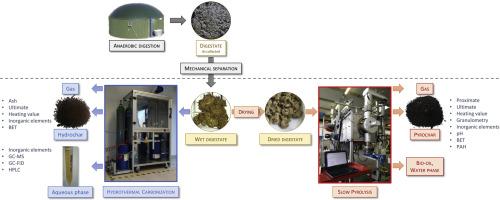Biomass & Bioenergy ( IF 6 ) Pub Date : 2020-06-17 , DOI: 10.1016/j.biombioe.2020.105593 Edoardo Miliotti , David Casini , Luca Rosi , Giulia Lotti , Andrea Maria Rizzo , David Chiaramonti

|
Carbonization of anaerobic digestion digestate from an Italian plant fed with local feedstock was investigated by slow pyrolysis (SP) and hydrothermal carbonization (HTC); the properties of pyrochar and hydrochar were compared and framed into the International guidelines for soil improvers/amendments in agriculture. Experiments were carried out in newly designed thermochemical conversion systems, with the aim of generating the original data necessary for future scale-up and for evaluating the characteristics of the product versus existing biochar market standards. SP was carried out in a paddle pyrolysis reactor at 500 °C for 1 h, while several HTC experiments were performed in a custom-made test bench, investigating the influence of temperature (200–250 °C) and time (0.5–3 h) on hydrochar properties. Both processes were run in batch mode. SP showed lower char yield (33.1%w/w db), while the maximum hydrochar yield was obtained at 200°C-0.5 h (72.6%w/w db). Most char properties fall within the thresholds set by biochar standards. The Carbon content was slightly higher for pyrochar (64.3%w/w db) than hydrochar (62.9%w/w db at 250°C-3 h). The specific area was rather low for both chars; however, pyrochar area (23.10 m2 g−1), was one order of magnitude higher than hydrochar. The ash content of pyrochar was nearly twice the hydrochar, while O/C and H/C ratio of the former were lower.
The HTC aqueous phase was also characterized in terms of inorganics concentration and organic composition. In average, the concentration of the former increased with reaction severity: more than 50 compounds were identified and 20 quantified. Acetic acid was the most abundant (up to 3.26 g l−1).
中文翻译:

实验室规模的生物质消化液的热解和水热碳化:固体产物的表征和生物炭标准的符合性
通过慢速热解(SP)和水热碳化(HTC)研究了意大利工厂的厌氧消化消化物的碳化。比较了焦炭和水焦炭的特性,并将其纳入国际农业土壤改良剂/改良剂指南中。实验是在新设计的热化学转化系统中进行的,目的是生成将来扩大规模所需的原始数据,并根据现有的生物炭市场标准评估产品的特性。SP在桨式热解反应器中于500°C进行1 h,而在定制的试验台上进行了几项HTC实验,研究了温度(200–250°C)和时间(0.5–3 h)的影响。 )上的炭火特性。这两个过程都以批处理模式运行。SP显示较低的焦炭收率(33.1%w / w db),而最大的水焦炭收率在200℃-0.5h(72.6%w / w db)下获得。大多数炭性质都在生物炭标准设定的阈值之内。焦炭(64.3%w / w db)的碳含量略高于水焦炭(在250°C-3 h下为62.9%w / w db)。两种字符的特定区域都比较低。然而,焦炭区(23.10 m2 g -1)比水焦炭高一个数量级。焦炭的灰分含量几乎是水焦炭的两倍,而前者的O / C和H / C比较低。
还根据无机物浓度和有机成分表征了HTC水相。平均而言,前者的浓度随反应的严重程度而增加:已鉴定出50多种化合物,并定量了20种。乙酸是最丰富的(最多3.26 g l -1)。


























 京公网安备 11010802027423号
京公网安备 11010802027423号